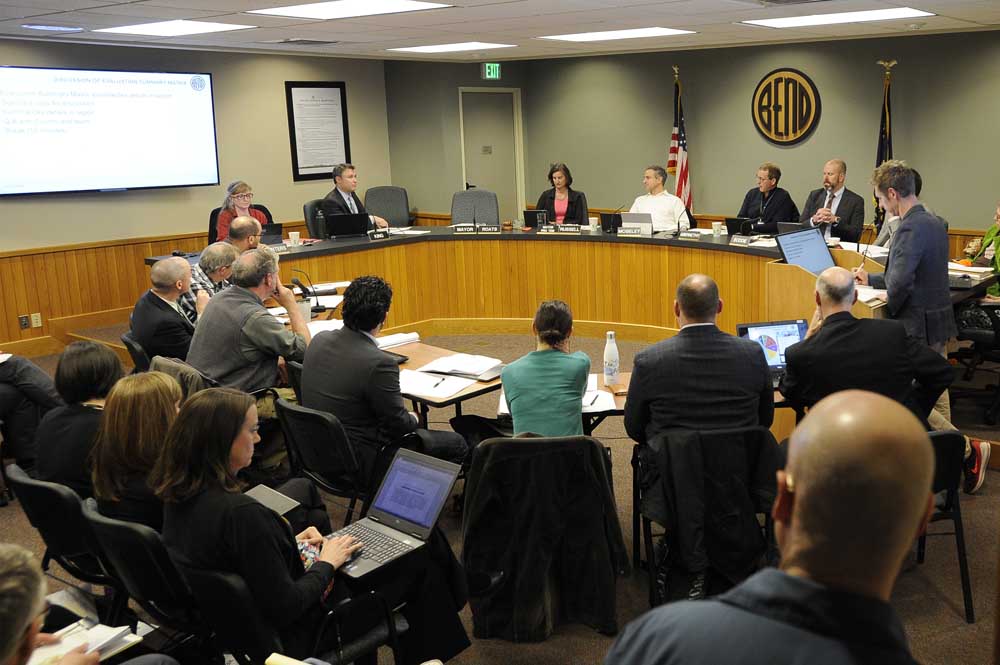Bend City Council hears from residents about growth
Published 12:00 am Thursday, April 5, 2018

- A Bend City Council meeting in March 2018.(Ryan Brennecke/Bulletin photo)
Several Bend residents urged the Bend City Council on Wednesday to invest in creating a denser, walkable area in the center of Bend, while others said the city needs to focus on developing more land on the outskirts of town.
Councilors are expected to decide April 18 how to prioritize city planning efforts to develop and annex about 2,380 acres outside city limits and redevelop some areas inside Bend. City staff and consultants favor focusing on the elbow-shaped area just southeast of the city limits and areas in the middle of town — including the Bend Central District, a 206-acre area that extends south from Revere Avenue to railroad tracks between the parkway and Fourth Street — that could be redeveloped with taller, denser residential and commercial buildings.
Residents, several of whom wore large yellow stickers with the Bend Central District’s logo, crowded the council chambers Wednesday to weigh in on where they want the city to focus.
Darci Palmer, an urban developer who lived in the Orchard District neighborhood adjacent to the Central District, said she wants to see Bend invest in redeveloping the center of town. Supporters of the Central District want Bend to invest in new infrastructure or other improvements in the area and pay for it with expected tax revenue through a process called tax increment financing.
“The Central District has the most untapped value, and it is most worthy of your enthusiastic investment,” Palmer said.
Infrastructure improvements in the Central District would include making streets safer for bicyclists and pedestrians.
Dorraine Budke, who owns Massage Solutions of Bend on Second Street, said she was hit twice in a 3-month period last year while riding her bike the half-mile from her home to her business. She said safety improvements in the Central District would help her and customers who want to walk or bike.
“I just feel like gosh, it’s such a missed opportunity to live that close to my place of business and not feel safe enough to walk or ride my bike,” she said.
Urban renewal is a key to making areas friendly for pedestrians and encouraging public transit, said Richard Ross, a board member of the Old Bend Neighborhood Association. Along with the Central District, he said he’d like to see the city focus on the Central Westside area, which includes Oregon State University-Cascades.
“The Central Westside and the Central District are our best bets for urban renewal,” he said.
But Dave Kyle, a resident of southeast Bend, said the city should focus on adding commercial development along 27th Street and developing the east side rather than building up the center of Bend.
“Don’t fall for the argument that increasing the magnitude and congestion of downtown is good city planning,” he said. “Put your money where most people live and where a lot more of them should shop and work.”
Brent Landels, a real estate agent who lives in southeast Bend, said he wants his children to have the same opportunities he’s had to own a home with a son, a daughter, a golden retriever and a cat. Bend needs more single-family homes, but city growth plans seem to call for more apartments, he said.
“We can’t just say everybody has to go rent an apartment and nobody gets to buy a house,” Landels said. “That’s not a conversation I want to have with my kids.”
About 75 percent of the city’s current housing stock is single-family detached housing now, said Jon Skidmore, Bend assistant city manager, and the median home price is out of reach for most Bend residents. The city intentionally chose to focus on adding different types of homes when it planned for growth, he said.
“As we turn into a real city, which we’re doing at a rapid pace, having a variety of housing types is important to the variety of people that we have coming,” Skidmore said.
James Dorofi, chairman of the Old Farm District neighborhood association in southeast Bend, used a rickety makeshift table to illustrate what he described as unfunded infrastructure in his part of town. It will take a lot of time and money to improve roads, including 27th Street, 15th Street, Murphy Road and Brosterhous Road.
“This developer-led growth that’s been happening the past few decades is creating islands of development with no infrastructure,” he said. “We’re not against growth. We’re not against development, but there’s so much needed, so much unfunded.”
— Reporter: 541-633-2160; jshumway@bendbulletin.com








